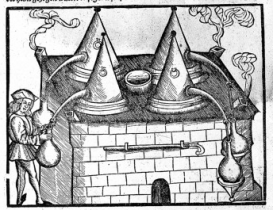The writings of the German apothecary and surgeon Hieronymus Brunschwig (c. 1450–1512) represent a significant episode in the history of science due to their seminal position—they were among the first medical works to be printed in the German language—and their unusual scope of sources and topics, ranging from surgery to medical alchemy. While individual aspects of Brunschwig’s work are well-known to historians of surgery and alchemy, the corpus of his writings as a whole has not been studied systematically, and its influence on early modern medical literature has yet to be fully realized.
The Alsatian surgeon-apothecary Hieronymus Brunschwig (ca. 1450–1512), despite his lack of university education, read widely and wrote prolifically in his native vernacular. He was the first of his profession to make use of the printing press, and, by fusing artisanal, alchemical, and learned medical traditions in his writings, became a widely-read authority on surgery and medical distillations. While this makes him a landmark figure in histories of medicine and pharmacy, his works are generally dealt with in isolation, and often cursorily. This project provided the first systematic study of their production and their influence on vernacular medical knowledge.
In particular, Tillmann Taape investigated how Brunschwig integrated his wide reading of medical and alchemical treatises with his emphasis on personal experience and empirical observation, and how this made for reliable medical book that appealed to wide audiences. This meant to situate Brunschwig’s works within histories of medical publications and vernacular genres, alchemy, "how-to" literature, and artisanal knowledge-making.
The instructions, anecdotes, and case histories in Brunschwig’s publications provided a starting point for studying the medical landscape of his home town, Strasbourg. Supplemented by an exploration of archival sources relating to the local hospitals, guild regulations, and correspondence, Tillmann Taape investigated the shifting boundaries between learned and "vernacular" practitioners.
Brunschwig’s works mark the beginning of the vernacular medical print tradition in the German lands, this seminal position begs the question to what extent Brunschwig had a formative influence on later vernacular or even learned writers. The numerous editions and translations of his works certainly suggest that he reached a wide range of readers, in the German lands and beyond. Their contemporary English translations were no less seminal than the German originals since they represented the first books on surgery and distillation available in the English language, and remained the only ones for years. Their obvious significance for the English medical print market demands an investigation of the role they played in medical controversies in early modern London, such as the ongoing power struggles between physicians, surgeons, and unlicensed practitioners, or the debate about chemical remedies. To this end, Taape closely compared the translations with the German originals to reveal how contents and tone were adjusted to appeal to a different readership. This contributes to our understanding of the transmission of natural knowledge in translation, a phenomenon that has only recently begun to attract scholarly attention.

